Modern dentistry in general, and orthodontics in particular, are making remarkable strides. Notably, braces without the need for traditional brackets and wires have become increasingly popular, replaced by high-aesthetic, clear aligner systems.
So, what are braces without brackets? Are they effective, and how much do they cost? All of these questions will be answered in the following article. Let’s take a closer look.
What Are Braces Without Brackets?
Braces without brackets is a modern and innovative orthodontic method. Instead of using traditional brackets, patients are custom-fitted with aligner trays based on the unique structure and shape of their misaligned teeth.
See more: All About Lower Jaw Braces
These trays fit snugly over the teeth, gradually moving them into the correct position on the dental arch without the need for wires or brackets.
The process begins with taking X-rays and impressions of the patient’s teeth. Then, the dentist uses software to simulate the expected changes in the teeth throughout the treatment process. This helps in determining an accurate treatment plan and in crafting the appropriate aligner trays.
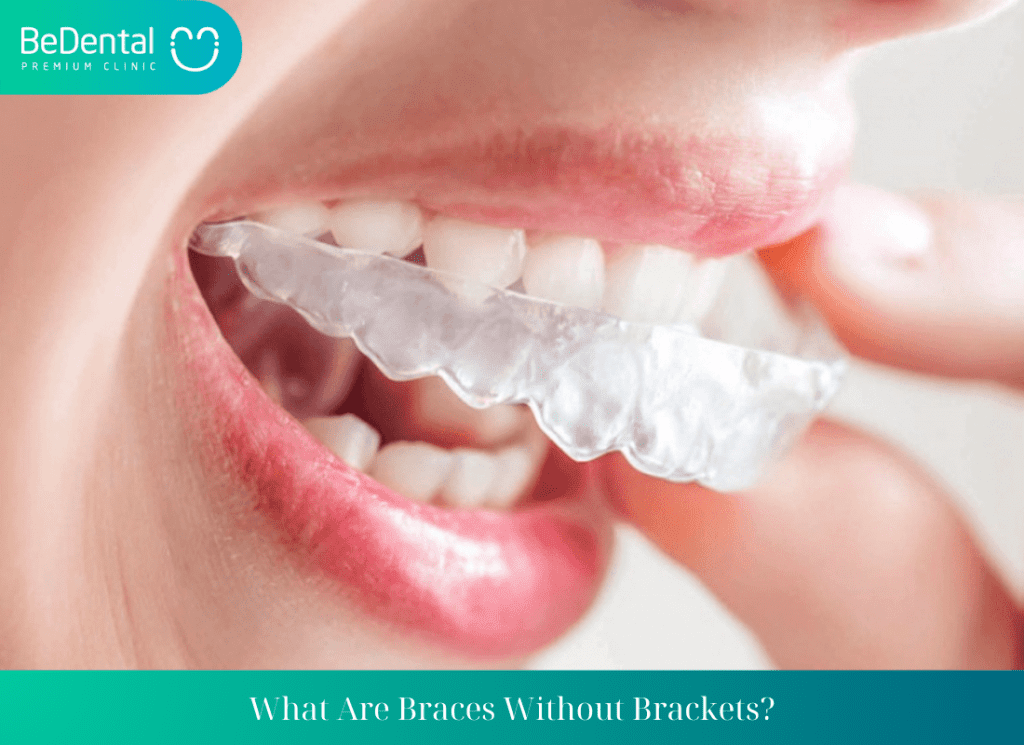
Each aligner tray is numbered sequentially, and patients typically wear each tray for about two weeks. Each tray moves the teeth approximately 0.25mm, and by continuously using the trays from start to finish, the teeth are gradually shifted into the desired position.
The Invisalign process usually requires between 20 to 40 aligner trays, and to ensure maximum effectiveness, patients should wear the aligners for at least 22 hours per day.
See more: Will Braces Cause Protrusion Again? Causes and Solutions
Popular types of clear aligner trays include Invisalign, 3D Clear, and Ecligner. These trays are made from transparent material and do not require brackets or wires.
Advantages of Braces Without Brackets
Comfortable to Wear
When using clear aligners (such as Invisalign), you won’t experience the discomfort caused by sharp brackets and wires. You also won’t have to endure the dull pain that comes from devices poking into your lips, cheeks, or tongue.
Invisalign trays are very smooth and do not irritate the inside of your mouth when you speak or smile. Their design is quite similar to teeth-whitening trays.
There are no sharp edges that could pose a danger. The trays are made from high-quality, biocompatible synthetic material, which is less likely to cause allergic reactions and has no unpleasant taste.
See more: Bone resorption when wearing braces
High Aesthetic Appeal
With clear aligners, no one will know you’re wearing braces. You can confidently take selfies, pose with friends, and participate in any activities without losing your confidence.
Due to the aesthetic appeal of clear braces, many actors, singers, and flight attendants choose this method. They can straighten their teeth while continuing to work without significant impact on their appearance.
Highly Convenient
When Invisalign and other clear aligner brands entered the Vietnamese market, they began offering technology transfer courses for orthodontists.
These courses help dentists understand the treatment process and the biomechanics of orthodontic care. Although Invisalign trays need to be sent to the U.S. for analysis and printing, this process has become more convenient. However, if you lose or break a tray, you’ll need to wait about 2-4 weeks for a new one to be printed and sent back to Vietnam.
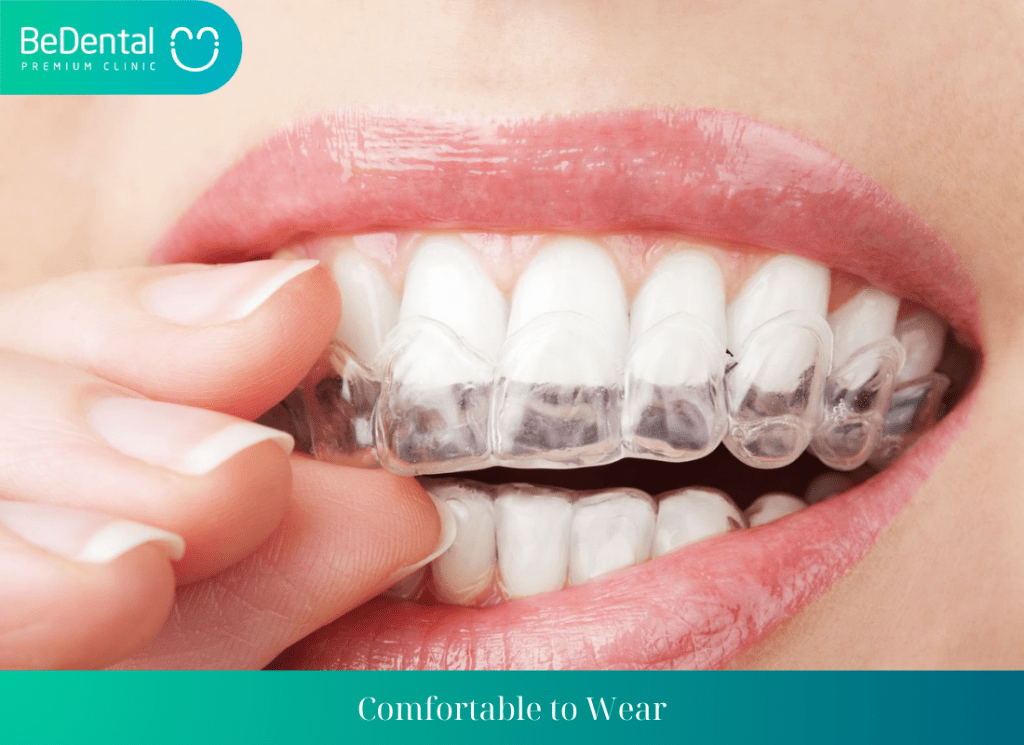
Easily Removable
With clear aligners, you can easily remove the trays when eating, brushing your teeth, or using dental floss. This is not possible with traditional braces, as the brackets are fixed to your teeth.
Thanks to the easy removability, you can eat anything without worrying about food getting stuck in the brackets, and oral hygiene becomes as simple as your regular routine.
See more: Things to know when wearing braces
Moreover, the risks of gum inflammation and soft tissue irritation are lower compared to traditional braces. This means you can comfortably dine out with friends without worrying about food sticking to your braces like before.
Easy to Clean and Maintain the Trays
Indeed, with clear aligners, the trays can become dirty after a period of use. However, cleaning them is very simple. You just need to use a soft-bristled toothbrush and rinse the trays under running water. Along with brushing your teeth daily, you should also clean the trays to keep them fresh and hygienic.
Additionally, if you want a brighter smile, you can combine whitening treatments or use whitening toothpaste. You can even apply a small amount of whitening gel into the trays and use them as a home whitening tray, which is very convenient.
How do clear braces without brackets differ from traditional braces?
Clear braces without brackets, such as Invisalign, differ from traditional braces in several key ways:
- Appearance: Clear braces without brackets are virtually invisible, making them a popular choice for those who prefer a more discreet orthodontic treatment option. Traditional braces use metal brackets and wires that are more noticeable.
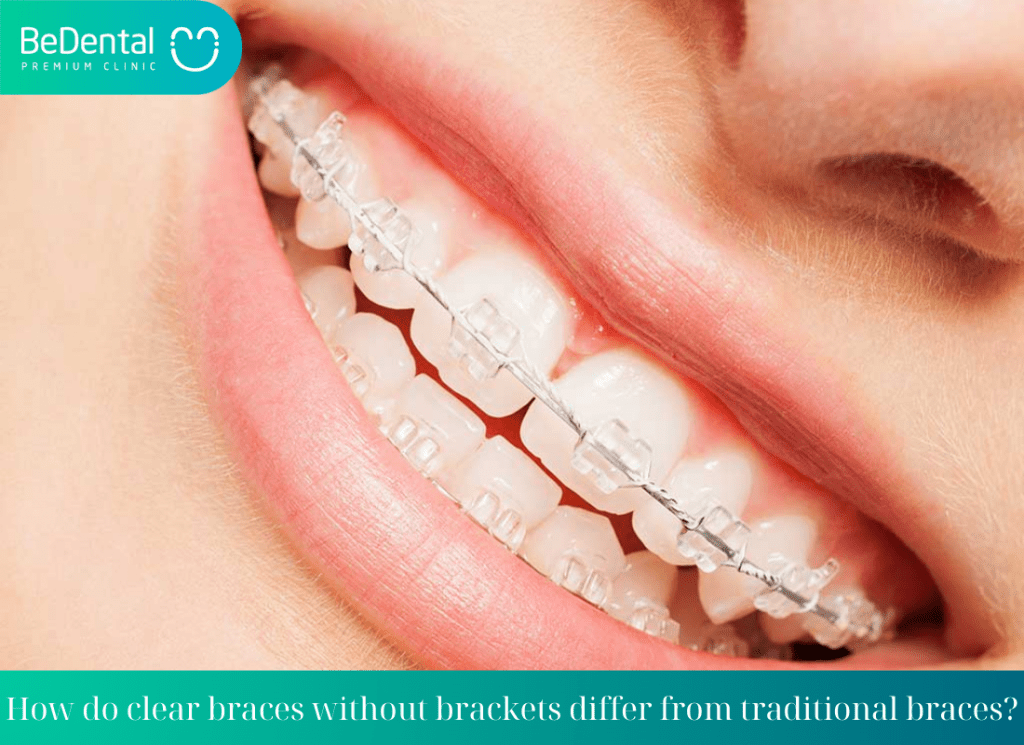
- Materials: Clear braces without brackets are typically made of a clear, smooth plastic material, while traditional braces use metal brackets and wires. This difference in materials can affect comfort and aesthetics.
- Removability: Clear braces without brackets are removable, allowing the wearer to take them out for eating, drinking, and oral hygiene. In contrast, traditional braces are fixed onto the teeth and cannot be removed by the wearer.
- Treatment Process: Clear braces without brackets use a series of custom-made aligner trays to gradually move the teeth into the desired position. Traditional braces rely on brackets and wires that are adjusted periodically by the orthodontist.
- Comfort: Clear braces without brackets are generally considered more comfortable than traditional braces because they lack metal components that can cause irritation to the cheeks and gums.
- Maintenance: Clear braces without brackets require regular cleaning and care to maintain their transparency and effectiveness. Traditional braces may require more intensive oral hygiene practices due to the presence of brackets and wires.
Overall, clear braces without brackets offer a more discreet, comfortable, and convenient orthodontic treatment option compared to traditional braces. However, the suitability of each option depends on individual orthodontic needs and preferences. It is essential to consult with an orthodontist to determine the best treatment plan for achieving optimal results.
Braces methods without brackets
Invisalign Braces
See more: Braces or Ceramic Veneers: Pros and cons

Exclusive technology from materials to tooth movement in Invisalign ensures that each aligner tray fits the dental arch closely and the pressure is designed to move the teeth according to the orthodontist’s plan. This ensures that, upon completion of the treatment, customers will have a proper bite and evenly straight teeth, as desired.
Ecligner Braces without brackets
Ecligner braces are a method originating from South Korea. This method has a lower cost compared to Invisalign, but the effectiveness is equivalent, making it very popular among customers.
See more: What Is the Appropriate Age for Braces?
Instead of using brackets and metal wires like traditional methods, Ecligner uses a series of clear aligner trays specially designed for each patient. This process starts with the dentist taking images and impressions of the patient’s teeth. Then, through digital technology and software, the dentist creates a specific treatment plan for each case, ensuring that the teeth move in the right direction and to the desired position.
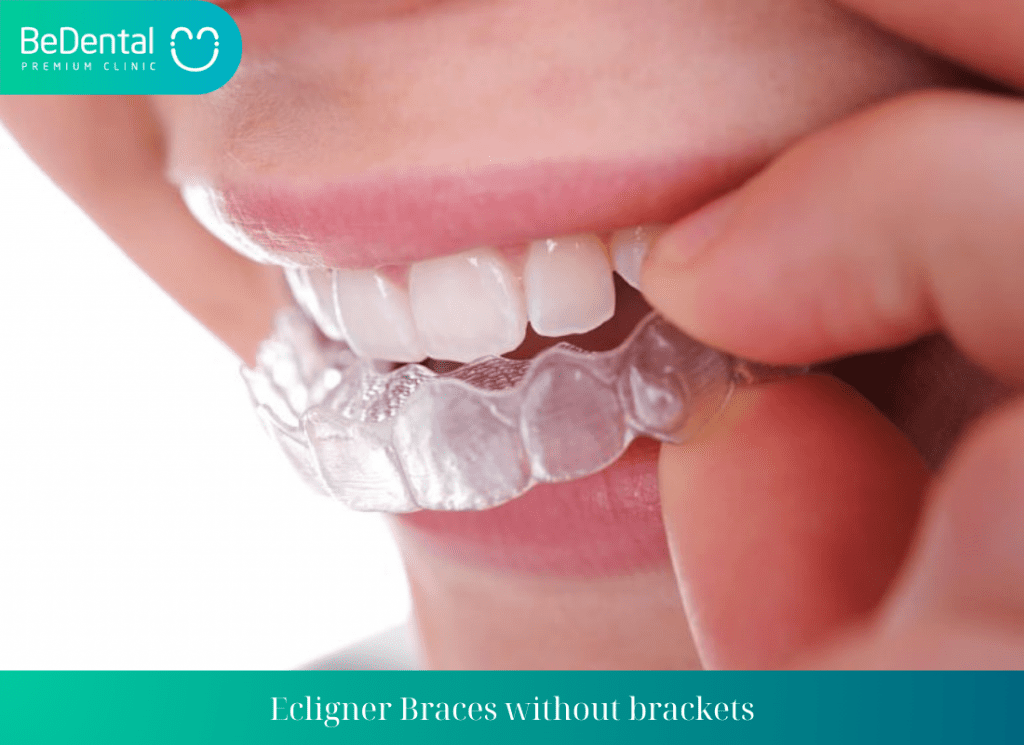
Clear braces without brackets 3D Clear
Clear braces without brackets 3D Clear, also known as Clear Aligner, is the first transparent braces method in Vietnam, based on technology from Germany. Being manufactured in Vietnam, the cost of this braces method is lower compared to other types of clear braces.
See more: What is Orthodontic archwire?
Clear braces without brackets 3D Clear uses 3D technology and design to create transparent aligners personalized for each patient. This is a modern, comfortable, and attractive teeth alignment method, helping patients feel more confident when adjusting their teeth without the inconvenience of traditional brackets and wires.
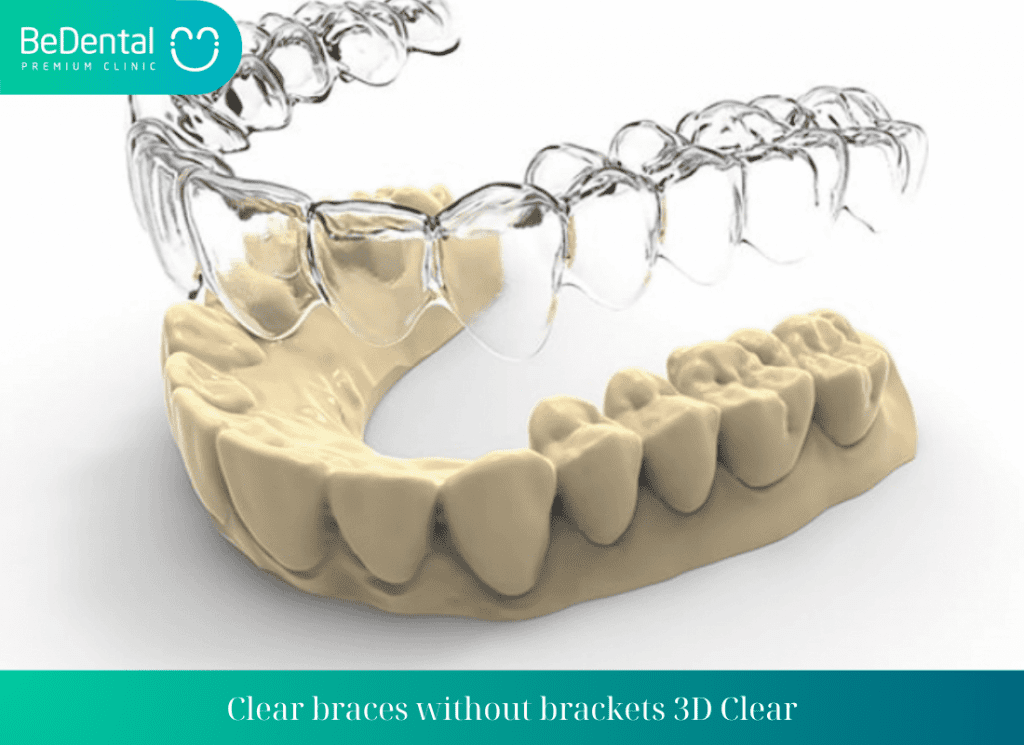
Cost for clear braces without brackets
What are cost for clear braces without brackets? Clear braces without brackets often have a relatively high cost, considered to be the most expensive braces option. This is because the aligner trays are custom-made for each customer, utilizing advanced manufacturing technologies.
In Vietnam, the most common method of clear braces without brackets is Invisalign. The price of Invisalign braces typically ranges from 40 million to 60 million Vietnamese Dong per arch.
The cost may be higher depending on the severity of teeth misalignment. For more challenging cases such as tooth extraction, significant misalignment, the cost will be higher compared to cases of minor spacing or mild misalignment.
See more: Signs of gum recession during braces
This article has helped you answer the question of what clear braces without brackets are. Wishing you success in your upcoming braces journey.
Conclusion
In conclusion, we have discussed various methods of orthodontic treatment, focusing on clear braces without brackets such as Invisalign, Ecligner, and 3D Clear. These modern approaches utilize advanced technology to provide personalized, comfortable, and attractive teeth alignment solutions. While clear braces without brackets may come with a higher cost compared to traditional methods, they offer the benefit of discretion and convenience.
Each method has its unique features and advantages, catering to different needs and preferences of patients seeking orthodontic treatment. Ultimately, the decision on which method to choose depends on individual factors such as the severity of misalignment and budget considerations. It is essential to consult with a dental professional to determine the most suitable treatment plan for achieving a beautiful and natural smile.
Tư vấn chuyên môn bài viết:
BÁC SĨ DƯƠNG THỊ THÙY NGA





